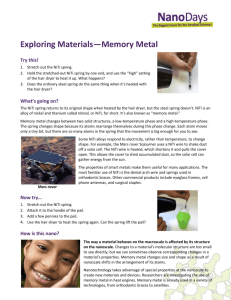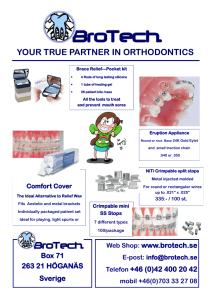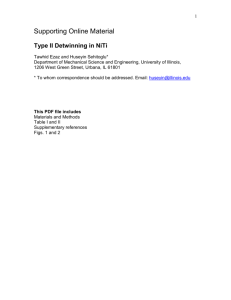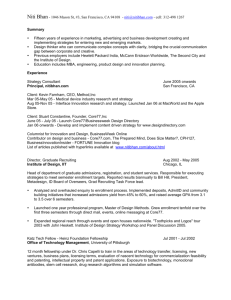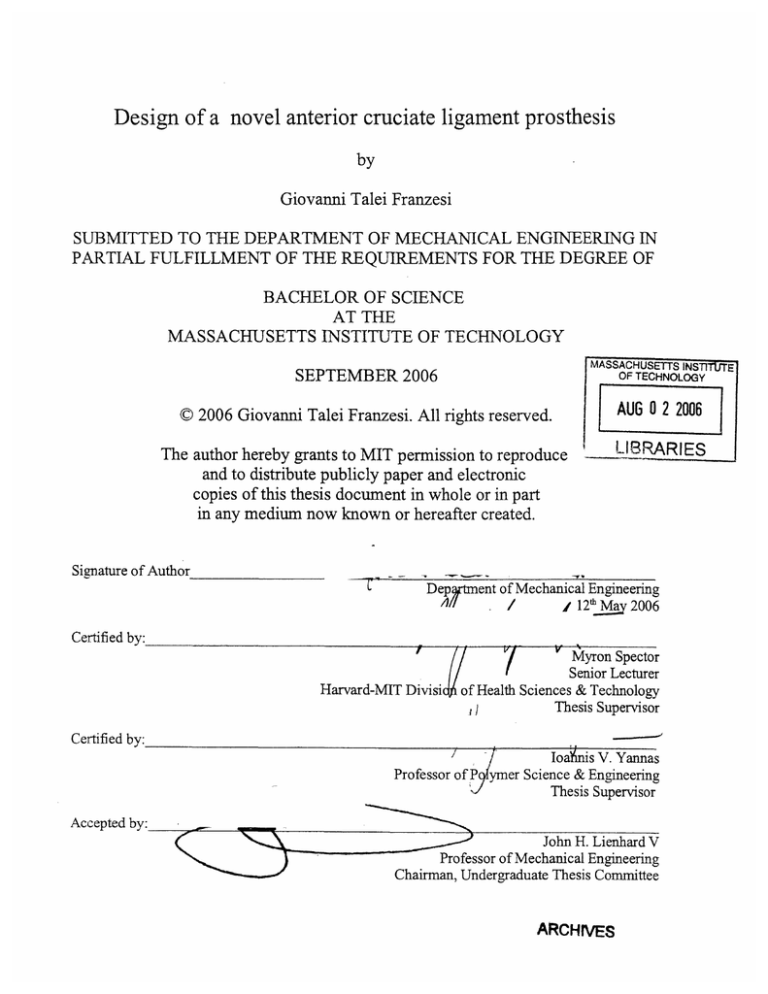
Design of a novel anterior cruciate ligament prosthesis
by
Giovanni Talei Franzesi
SUBMITTED TO THE DEPARTMENT OF MECHANICAL ENGINEERING IN
PARTIAL FULFILLMENT OF THE REQUIREMENTS FOR THE DEGREE OF
BACHELOR OF SCIENCE
AT THE
MASSACHUSETTS INSTITUTE OF TECHNOLOGY
MASSACHUSETTS
INST[iE
SEPTEMBER 2006
OF TECHNOLOGY
AUG 0 2 2006
) 2006 Giovanni Talei Franzesi. All rights reserved.
LIBRARIES
The author hereby grants to MIT permission to reproduce
and to distribute publicly paper and electronic
copies of this thesis document in whole or in part
in any medium now known or hereafter created.
Signature of Author
4
L
Depytment of Mechanical Engineering
/
12thMay 2006
t//
Myron Spector
Senior Lecturer
Certified by:
r
/'
Harvard-MIT Divisi
of Health Sciences & Technology
I
o
Thesis Supervisor
Certified by:
Ioanis V. Yannas
Professor of Plymer Science & Engineering
Thesis Supervisor
Accepted by:
.
John H. Lienhard V
IIm
Professor of Mechanical Engineering
Chairman, Undergraduate Thesis Committee
ARCHIVES
Design of a novel anterior cruciate ligament prosthesis
by
Giovanni Talei Franzesi
Submitted to the Department of Mechanical Engineering
on May 12, 2006 in Partial Fulfillment of the requirements
for the Degree of Bachelor of Science at the
Massachusetts Institute of Technology
ABSTRACT
Injuries to the anterior cruciate ligament (ACL) are extremely common (approximately 100,000
every year in the US) and result in greatly reduced mobility; although several surgical procedures
have been devised to address this condition, they are far from being completely satisfactory. The
golden standard is currently represented by tendon autografts which, however, result in
considerable donor site morbidity. An ideal solution would be to use effective, off-the-shelf
permanent prostheses: however, all such devices proposed to date have proved highly
disappointing, because of poor long term stability and biocompatibility, and unphysiological
mechanical behavior. To address both concerns a novel prosthetic device has been developed,
employing crimped NiTi superelastic wire bundles. To achieve near-physiological mechanical
behavior, the fiber geometry resembles (on a much larger scale) that of the collagen fibrils that
naturally make up the ligament, using as a starting point the Comninou-Yannas crimped-fiber
model. NiTi (a superelastic alloy of titanium and nickel) has been tested and employed in a variety
of biomedical settings and its excellent wear and biocompatibility characteristics make it a superior
candidate for this application; the relevant literature has been reviewed and assessed. A detailed
design for such prosthesis has been proposed, and a proof-of-principle model of the fiber geometry
built and tested. The results obtained to date are encouraging and further testing, with a NiTi
prototype should be carried out to validate our proposed design.
Thesis Supervisor: Myron Spector
Title: Senior Lecturer
Thesis Supervisor within the Department of Mechanical Engineering: Ioannis Yannas
Title: Professor of Polymer Science and Engineering
.Introduction and rationale of the investigation
The anterior cruciate ligament (ACL), that originates from the tibial plateau just medial
and anterior to the tibial eminence, provides 85% of the total restraining force to anterior
translation of the tibia. An ACL tear is a common injury that occurs in all types of sport:
epidemiological studies estimate that approximately 1 in 3000 individuals sustains ACL injury
each year in the United States [1,2]. This figure corresponds to an overall injury rate approaching
100,000 injuries annually, and, as the physically active percentage of the population increases, this
figure is bound to rise, as well.. Until the introduction of arthroscopic surgery in the 70's, there
were essentially no remedies for an ACL tear. Given the seriousness of the injury, that can
severely restrict the motility of the patient, several therapies have been devised, aimed either at
suturing or substituting the broken ligament. In the latter case, the grafts are either autografts or
synthetic prostheses. Although autografts, usually taken from the patellary tendon, represent the
gold standard, are associated with donor site morbidity, increased complexity of the operation
itself, and unphysiological mechanical characteristics[3,4]. Sythetic prosthese designed ab-initio
for ligament replacement could overcome such problems; however, all attempts made so far have
been highly disappointing, due either to fracture/fatigue problems or particle release [5,6,7,8]. The
purpose of this investigation was to devise and assess the feasibility of a novel type of permanent
ACL prosthesis that takes advantage of the peculiar properties of NiTi alloys.
2.Method of approach
Since its very inception this investigation was meant to be above all a literature-review
study, aiming at assessing the feasibility of a particular strategy for the replacement of human ACL
before having to perform any actual experiments in the lab. Though this approach was dictated to a
3
large extent by financial constraints, it allowed us to take advantage of the wealth of data already
available in the literature, and limiting to a minimum the number of questions we would still need
to answer through ad-hoc experiments. Furthermore, it gave us greater freedom in pursuing
different strategies, comparing different materials, before committing to a final design.
The first part of our research focused on understanding the structural and mechanical
properties of the ACL, as well as its mechanicalrole in the knee during the different phases of
motion. Secondly, the current therapeutic approaches to ACL reconstruction were reviewed, both
the use of allografts and synthetic prostheses. The analysis of previous models of synthetic
prostheses, and of the defects that lead to them being withdrawn from clinical use, was particularly
instructive in shaping our goals for a novel design. In particular, all previously designed
prostheses presented insufficient tribological characteristics,eventually leading to mechanical
failure, and, even before that, unnatural stiffness, typically several times that of native ACL,
leading to gait and back problems. Therefore, we wanted to design a prosthesis with both superior
resistance to wear and more physiological mechanical properties.
The excellent tribological characteristics of NiTi alloys, combined with their exceptional
biocompatibility immediately recommended it as a leading candidate for this use. Furthermore, as
several models have been proposed [9,10,11] to explain collagen properties on the basis of fiber
coiling and "waviness", we realized that the stiffness of the prosthetic construct could be altered,
and the behavior of the native ligament mimicked, by altering the shape of the NiTi fibers
composing it. Because of its simplicity and efficacy, the Yannas-Comninou model [9] was used as
a starting point.
It was then essential to review the massive available literature concerning NiTi
biocompatibility in vitro, in animal models, as well as in clinical applications, to see if we could
4
conclude that it would be safe in this application, too. The data gathered strongly suggests it, and
in a later chapter we propose experiments that would definitively settle the issue. A similar
approach was taken with regard to NiTi alloys wear resistance, the other essential feature for the
success of the proposed prosthesis. A prototype was then designed, and tests on the proposed fiber
geometry were carried out employing bundles of sinusoidal thin copper wires.
We then proposed a set of further experiments that would allow a more conclusive
investigation regarding the clinical potential of the proposed device.
3.ACL Physiology
In order to correctly mimic the human ACL, the extensive literature surrounding it was
reviewed; the data collected was at times hard to fit into a coherent framework because of the wide
range of testing protocols, formats, and units employed (for example, N/mm vs. Mpa), as well as
the exceptional variability of the object of study, human ACL, according to age, size, and weight,
making the estimate of 'average" values somewhat arbitrary[l 1,12,13,14]. For safety reason, the
ultimate tensile strength of the ligament has been taken to be 2200N, which is the upper bound for
a young, healthy ligament in any study[14]. On the microscale, the ligament appears composed on
axially oriented collagen fibrils, assembled in fascicles, that, in turn are organized in several
bundles. On the macroscale, three major structures, or bundles can be identified, a posterolateral
bundle (PLB) and two anteromedial bundles(AMB).
The PLB has an (average) modulus of approximately 160 MPa and a maximum stress of
18MPa, compared to values of 280and 28 MPa for the AMB[13]. The two sets of bundles exert
different functions in knee kinematics, the PLB being mainly responsible for rotational stability in
flexion and the AMB for rotational stability in extension; moreover, depending on knee flexion
angle, the two bundles have unequal contributions to load transfer across the knee joint.
5
4.Synthetic prostheses
Over the years, there has been a wealth of synthetic substitutes for the ACL being proposed, both
as permanent replacement devices, and as assistive, orthotic, devices. Though it can be claimed
that they fulfill the orthotic niche quite nicely[15], until now all attempts at developing a successful
synthetic prosthesis have failed.
Table 1: selection of proposed synthetic prosthesis and their description[5,7,8]
Commercial name
Description
Material
Stryker
4-6 woven tapes in tubular shell
PET/PP
proflex
15 concentric tubular braids of 32 yarn
PET
Lygeron
6 ribbons in a woven tube
PET
Kennedy-Lad
Braided narrow ribbons
PP
Leeds-Keio
mesh
PET
ABC Surgicraft
24 braided narrow ribbons wrapped at ends
PET
Ligastic
Tubular knit with polyurethane shell
PET
Raschel
Knitted structure rolled into tubular shape
UHMWPE
Braided PHP
Double concentric tubular braids
UHMWPE
Ligaid
Twisted cord braids wrapped at ends
PAA
Gore-Tex
24 braids of 3 yams wrapped at the end
PTFE
Two modes of failure were evident: mechanical failure, in which the implant simply broke or
became detached[5,7], and failure via inflammation and osteolysis induction[7], because of
particles generated as the prosthesis wore down. In particular, SEM observations of recovered
fibers revealed that abrasion of the textile fibers as a result of yarn-on-yarn and/or yarn-on-bone
contact was a common phenomenon to almost all models[6,7], and was possibly the primary cause
of prosthetic failure. Torsional and flexural fatigue of the fibers was also observed [7]. The
collagenous infiltration present in certain prosthesis didn't act as a budding regenerated ligament,
but rather showed a random, scarlike structure and, if anything, caused deterioration and fraying
6
of the textile fibers by infiltrating among them and disrupting their organized pattern[6]
Overall, the expexted lifespan of these prosthes is limited to a few years in the best of
cases, with up to 80% failing at 5 years post surgery [16] and even less in groups that subject their
knee to substaintial strains such as athletes or soldiers [17].
5.NiTi
5.1 General characteristics
The first succesfull shape memory alloy based on an almost equiatomic mixture of Nickel and
Titanium was discovered in the 1960's by Buehler and colleagues at the Naval Ordnance
Laboratory (hence the name Nitinol) By the early 70's [18], its first medical applications were
being explored. NiTi shape memory alloys can exist in two different temperature-dependent crystal
structures (phases) called martensite (lower temperature) and ustenite (higher temperature, or
parent phase). Several mechanical properties of the material change according to the phase:
martensitic NiTi is soft and ductile, stress-induced martensitic (superelastic) NiTi is highly elastic,
while austenitic NiTi is strong and hard, similar to pure titanium. The term superelasticity refers to
the ability of NiTi to return to its original shape after a substantial deformation. This is based on
stress-induced martensite formation: the application of an outer stress causes martensite formation
at a higher temperature than normal, accommodating the imposed deformation. When the stress is
released, the martensite transforms back into austenite and the speciment returns to the original
shape. This mechanism allows to sustain elastic deformations (up to 8%) several times greater
than normal metals, and is considered essential to NiTi's exceptional fatigue and wear resistance,
highly desirable properties in a material employed in aligament prosthesis.
Table : selected mechanical properties of NiTi, Stainless Steel and Titanium[19]
7
Material
Austenitic NiTi
MartensiticNiTi
Stainless Steel
Titanium
Ultimate tensile
Strength (Mpa)
800-1500
103-1100
483-1850
540-740
Tensile yield
Strength (Mpa)
100-800
50-300
190-1213
390
Modulus of
Elasticity (Gpa)
70-110
21-69
190-200
105-110
Elongation at
failure (%)
1-20
60
12-40
16
5.2Biocompatibility
The primary characteristic of any material destined to be implanted permanently in the human
body is biocompatibility, therefore the early focus of my research has been to review the available
literature concerning NiTi biocompatibility. Of particular concern was the possible release of Ni,
of known toxicity and carcinogenicity, following implant surface corrosion and degradation.
Though the studies by en large presented NiTi as an extremely safe material for medical
application, considerable disparities were observed in corrosion resistance and citotoxicity
depending upon surface preparation of the samples. The studies conducted can be divided into
three broad categories: in vitro studies, studies conducted in animal models, and a posteriori
analysis of clinical outcomes; i will briefly summarize the most important ones in each category,
and then describe surface treatment and sterilization techniques which hold promise for further
improving the suitability of NiTi for medical use.
5.2.1In vitro studies.
The first step toward establishing the biocompatibility of NiTi is customarily carried out in vitro,
with cells grown on, or near, the substrate under scrutiny; cell proliferation , cell morphology and
enzymatic activities are then assayed, and compared to a control population. A selection of in vitro
cytotoxycity studies is summarized in table 2
8
Table 2: selected assessments of in vitro citotoxicity of NiTi alloys [20,21,22,23,24,25,26,28,29]
Assessment of
Assay used
Cell type
biocompatibility
proliferation
good
IL132, HEMP
proliferation, viability
moderate, inferior to Ti
Rat fetal lung
proliferation
good
Prim. Human
fibroblasts
proliferation
good
L929
Morphological
good
Prim. Murine
splenocytes
fibroblasts
evaluation
Prim. human epithelial
Morphological
cells
evaluation
Prim. Human
fibroblasts
Proliferation
good
good
Prim human fibroblasts proliferation
good, comparable to Ti
Osteosarcoma cells
(MG-63, SAOS-2)
prim. human
Proliferation,
morphological
examination
good
Enzymatic activity
good
osteoblasts (HOB),
murine fibroblasts
(3T3)
Prim. human epithelial
cells
5.2.21n vivo studies
Since the early 70's, a variety of animal studies have been conducted to test both the
biocompatibility of NiTi alloys and the efficacy of the devices constructed from it.
Table 3 selected in vivo assessment of NiTi biocompatibility [30,31,32,33,34,35,36]
Targettissue
Animal
Assessment of
Biocompatibilityevaluation
model
rabbit
muscle
histocompatibility
good
rat
muscle
histocompatibility
good
9
Animal
model
Targettissue
Guinea pig, skin
rabbit. mice
Assessment of
Sensitization,
irritation, systemic
Biocompatibilityevaluation
good
toxicity
rat
bone, periosteum
histocompatibility
good
rabbit
oral mucosa
genotoxicity
good
rabbit
tendon
histocompatibility
good
dog
bone
histocompatibility
good
rat
dermis
histocompatibility
good
rabbit
bone
histocompatibility
good
5.2.3Clinical implants
However, the ultimate test for a material's usefulness as an implant constituent comes from clinical
experience: over the years, several devices have been approved by the FDA and have seen
widespread clinical use in the US. The first device to be approved was the Simon Nitinol Filter,
used to treat pulmonary embolism[37]. The filter was inserted as as a straight thin wire via the
catheter used normally in angiographic diagnosis; upon reaching the lumen of the vena cava and
sensing body temperature, it reverts to its original complex filter shape, trapping any circulating
thromboemboli. A similar approach is followed by the vastly successful self-expandable NiTi
stents: the low-temperature (thin) stent is inserted into the narrowed artery, where it heats and
expands, dilating the lumen. Thousands of such devices have been implanted since the late nineties
and in all the studies reviewed [38,39,40] no significant problem emerged linked to the use of NiTi
as a permanent implant. Further applications of NiTi stents have been found, and approved by the
FDA, in gastroenterology (for the treatment of biliary strictures both benign and malign, [41]), as
well as in urology[42]. However,most of our data regarding long-term implantation of NiTi
constructs comes from the fields of orthopedics and orthodontics. In orthopedics, NiTi has been
10
used with success as memory-shape fixation devices[43,44,45]. In orthodontics, it has established
itself as the premiere brace material[46,47].
5.3Fatiguebehavior
Since the ligament prosthesis will be subjected to an estimated 3-4 million cycles per year, one
fundamental characteristic of the material to be taken into consideration during the design process
is fatigue resistance. In particular, because of the nature of the loading in the physiological setting,
it is important to take into consideration both pull-pull and bending/torsion fatigue tests. The
considerable literature available in this regard suggests a safe value of approximately 0.5% strain,
at temperatures similar to that of the body [48,49,50].
5.6Wearand corrosion resistance
NiTi alloys have been reported to have exceptional wear and corrosion resistance properties
(up to two orders of magnitude less wear than steel or titanium)[51,52], particularly after surfacehardening treatments, such as plasma source ion (especially nitrogen, oxigen and
argon)[53,54,55,56,57] implantation. Ion implantation is particularly suited for surface
modification of NiTi alloys because it is carried out at near-room temperature, without altering the
peculiar mechanical properties of the material. Furthermore, the modified surface layer is
compositionally graded, so that there is no distinct interface with the bulk material, preventing the
risk of delamination. Increasing wear and corrosion resistance, in turn, would further increase
NiTi biocompatibility.
There is, however, a lack of specific, quantitative data (particle generation
and particle size) for wire-wire contact, as well as for NiTi surfaces sliding in a physiologically
lubricated environment. Such questions should be addressed with ad-hoc experiments.
5. :7Sterilization
Finally, an important consideration was the possibility for NiTi wires (subjected to a
11
variety of surface treatments) to be sterilized via common methods without substantial degradation
or alteration of their mechanical behavior or biocompatibility. Of the methods reviewed in the
literature, ethylene oxide sterilizations seems the most satisfactory [58,59].
6.The Yannas-Comninou model
In order to ensure the clinical effectiveness of the prosthesis, it is important to try and
match as closely as possible the ACL's native mechanical properties. In Particular, a relatively soft,
viscoelatic material capable of high life cycles at high strain rates has to be mimicked using a
relatively stiff, linear-elastic material, much less amenable to high strains. To accomplish this, we
turned to a model developed by Yannas and Comninou [9] deriving the observed properties of
ACL from the peculiar crimped, or sinusoidal, architecture of the single, relative stiff and linearelastic collagen fibers. In a nutshell, the high apparent, macroscopic strain (given by the change in
length over the original length) observed is due to a "flattening" of the fiber, which only undergoes
a much less pronounced microscopic strain
Following Yannas and Cominou derivation, we wish to establish a simple mathematical
relationship between the geometrical parameters of a sinusoidal fiber (of the form y = a sinbx) and
its apparent strain under a given stress. We consider the stress (a) only in the direction of the fiber
(denoted by X in the usual x,y,z coordinate system), so that
(1)
(2) o (y) =
(x),
(z) = t(xy) = t(xz) =t(yz),
where E is Young's modulus and
t
the shear. The strains then are
(3) (x) =(l/E)[o(x)- v(a(y) + o(z)] = o(x)/E
(4) (y) =(1/E)[6(y)- v(a(x) + a(z)] = -va(x)/E
(5) (z) =(l/E)[a(z)- v(a(x) + (y)] = -vo(x)/E
(6) y(xy)= y(xz)=
zy)= 0
12
If we denote by I the moment of inertia of the wire, a its wave amplitude and b the frequency, we
can use equilibrium and geometric compatibility constraints to derive a constitutive equation []
relating the stress in the fiber and the apparent uncrimping, denoted by ot
(7)c(x) = Ex - [(EaA2*bA2)/4]*[A(A+2)/(A+l
)A2],
where A= Ao(x)/bA2*RA2
However, we are only interested at small levels of stress and microscopic strain, so that A<< 1.
We have then:
(8)A(A+2)/(A+1)A2 _ 2A
Substituting and rearranging, we then obtain,
(9) c(x)= [E*R^2/(R^2 + 2a^2)]*cc.
[E,*RA2/(RA2+ 2aA2)], then is the effective stiffness of the wire, that can be altered by adjusting
the wire thickness and wave amplitude, under the condition that A<< 1.
7.The design
Mimicking the original ligament, the prosthesis will be composed of two bundles, an
anteromedial (AMB) and a posterolateral (PLB)one, similar in size, orientation, and mechanical
characteristics to the ones in the ACL. Their rest lengths would be 10cm for the posterolateral
bundle and 85 mm for the anteromedial bundle, with corresponding stiffnesses of 160 and 280
Mpa. The different stiffnesses will be obtained by altering the crimp angle, and wave
amplitude/radius ratios of the fibers in the two bundles. For wires 0.5 mm in diameter, commonly
available in medical grade for orthodontic applications, with a Young's modulus of approx.
40GPa, this would translate into wave amplitude of 2.8 and 2.1 mm respectively, with a
wavelength of 10
Omm. Note that with these parameters even the reported maximum stresses in the
13
two bundles would cause a material strain substantially less then the threshold (0.5%) indicated in
the literature as safe for virtually infinite lifetime. The fibers will be connected to two terminal
bone attachment points either via crimping or plasma welding. To insure fixation, instead of the
current bone-plug method, devices similar to those used for dental implants could be used, taking
advantage of the shape-memory behavior of the NiTi .
Pretensioning is an essential aspect of the implantation of current artificial ligaments,
highly influential on the prostheses effectiveness, and would be greatly facilitated by the memoryshape behavior of NiTi: the prosthesis could be implanted (cold) in an elongated state and would
tend to shorten as it reaches body temperature, generating a predetermined force level.
8.Proof of principle testing
As we were unable to obtain sinusoidal NiTi wire, we employed bundles of sinusoidal copper wire
(made up by 10 1 mm wires) to test the effect of fiber geometry upon apparent stiffness and
elasticity. 3 sets of such bundles, characterized by different values of amplitude:radius ratios (1:1,
3:1, 5:1, 10:1) where tested in elongation, and compared with a bundle made up of straight wire.
As they were subjected to the same load, the respective apparent stiffness values could be obtained
from the different macroscopic deformations. As we can see from the graphs below, the simple
model we employed describes fairly well the material behavior at low strains
14
c
0
0
E
* predictedvalues
a Set1
Set2
x Set3
ca
So
E
0.
fi
a
amplltude:radlusratio
Figure 4: predicted and experimental ratios of apparent stiffness to young modulus vs. fiber r/A ratio.
9.Conclusions
The proposed artificial prosthesis for repair of the anterior cruciate ligament holds promise
as a considerable improvement upon available ACL replacements, both autografts and synthetic
prostheses, in terms of long-term performance, patient recovery of articular function, as well as
ease of use. Although laboratory testing of the proposed design is still needed in order to fully
characterize the behavior of the prosthesis prior to animal testing, the use of a well-established
material and mechanical model has allowed a fast development of the original idea. A thorough
review of the available literature has underlined the exceptional properties of nickel-titanium alloys
for this particular application, with regard to both biocompatibility and tribological properties.
Experiments that should be carried out to further validate the idea depend upon the realization of a
proof-of-principle prototype made with sinusoidal NiTi wires; though fairly expensive, it's a
service performed commercially by several companies, such as Guelph Wire Products or medical
valley LLC. Such prototype should then be subjected to in vitro testing of mechanical properties,
15
wear resistance and particle generation, possibly in a simulated environment mimicking the in-vivo
conditions. In this regard, the technology developed for the testing of total knee replacement
prostheses would prove very valuable and should be easily adaptable.
16
9.References
[l]Adam F, Pape D, Kohn D, Seil R., Arthroscopy. 2002 Oct; 18(8):859-64.
[2]Freedman, K.B.; D'Amato, M.J.; Nedeff, D.D.; Kaz, A.; Bach Jr., B.R., (Chicago, IL): Am J
Sports Med. 2003 Jan-Feb;31(1):2-11
[3]Herrington L, Wrapson C, Matthews M, Matthews H. Related Articles,Knee. 2005
Jan;12(1):41-50.
[4]Sherman OH, Banffy MB. Arthroscopy. 2004 Nov;20(9):974-80.
[5]Silver FH, Tria AJ, Zawadsky JP, Dunn MG.J Long Term Eff Med Implants.
[6]Murray et. Manicol, knee. February 2004; 11(1) 9-14
[7]Schepsis AA, Greenleaf J. Orthop Rev. 1990 Nov; 19(11):984-91
[8]Zoltan DJ, Reinecke C, Indelicato PA. Clin Sports Med. 1988 Oct;7(4):773-84. Review.
[9]yannas, Comninou J Biomech. 1976;9(7):427-33.
[10] Alan D. Freed et Todd C. Doehring Journal of Biomechanical Engineering -- August 2005 -Volume 127, Issue 4, pp. 587-593
[11]Fratzl, P., Misof, K., Zizak, I., Rapp, G., Amenitsch, H., and Bernstorff, S., 1997, J. Struct.
Biol., 122, pp. 119-122
[12]ChandrashekarN, Mansouri H, Slauterbeck J, Hashemi J.J Biomech. 2006 Jan 4
[13]F.R. Noyes and E.S. Grood, Journal of Bone and Joint Surgery of America 58 (1976), pp.
1074-1082.
[ 14]Dienst M, Burks RT, Greis PE.Orthop Clin North Am. 2002 Oct;33(4):605-20
[15]0OchiM, Adachi N, Deie M, Kanaya A. Arthroscopy. 2006 Apr;22(4):463.el-5.
[16]Riel KA. Zentralbl Chir. 1998;123(9):1014-8.
[17]Bowyer GW, Matthews SJ. J R Army Med Corps. 1991 Jun;137(2):69-75.
[18]Baumgart F, Bensmann G, Haasters J, Nolker A, Schlegel KF.Arch Orthop Trauma Surg. 1978
Feb 10;91(1):67-75.
[19]Jakko Puranem, oulu university library 1997
[20]Shabalovskaya SA (1996) Biomed Mater Eng 6:267-289
[21Rondelli G, Vicentini B (1999) Biomaterials 20:785-792
[22]E1Medawar L, Rocher P, Hornez JC, Traisnel M, Breme J, Hildebrand HF (2002) Biomol Eng
19:153-160
17
[23]Assad M, Lombardi S, Bemrnche S, Desrosiers EA, Yahia LH, Rivard CH (1994) Ann Chir
48(8):731-736
[24]Ryhanen J, Niemi E, Serlo W, Niemeli E, Sandvik P, Pernu H, Salo T (1997) J Biomed Mater
Res 35(4):451-457
[25]Assad M, Chernyshov A, Leroux MA, Rivard CH (2002) Biomed Mater Eng 12:225-237
[26]Bogdanski D, K611erM, Mfiller D, Muhr G, Bram M, Buchkremer HP, St6ver D, Choi J,
Epple M (2002) Biomaterials 23:4549-4555
[27]Es-Souni M, Es-Souni M, Fischer-Brandies H (2001) Biomaterials 22:2153-2161
[28]Es-Souni M, Es-Souni M, Fischer-Brandies H.Anal Bioanal Chem. 2005 Feb;381(3):557-67.
Epub 2005 Jan 20.
[29]Rhalmi S, Odin M, Assad M, Tabrizian M, Rivard CH, Yahia (1999) Biomed Mater Eng 9(3):
123-134
[30]Rhalmi S, Odin M, Assad M, Tabrizian M, Rivard CH, Yahia LH (1999) Biomed Mater Eng
9(3):151-162
[3 1]Ryhinen J, Kallioinen M, Tuukkanen J, Junila J, Niemeli E, Sandvik P, Serlo W (1998) J
Biomed Mater Res 41(3):481-488
[32]Assad M, Chernyshov A, Leroux MA, Rivard CH (2002) Biomed Mater Eng 12:339-346
[33]Kujala S, Ryhinen J, Danilov A, Tuukkanen J (2003) Biomaterials 24:4691-4697
[34]Ryhainen J, Kallioinen M, Tuukkanen J, Lehenkari P, Junila J, Niemel
E, Sandvik P, Serlo W
(1999) Biomaterials 20:1309-1317
[35]Kujala S, Pajala A, Kallioinen M, Pramila A, Tuukkanen J, Ryhinen J (2004) Biomaterials
25:353-358
[36]Assad M, Chernyshov A, Leroux MA, Rivard CH (2002) Biomed Mater Eng 12:339-346
[37]roctor MC, Cho KJ, Greenfield LJ. J Surg Res. 2003 Mar; 1 10(1):241-54.
[38]Dai K, Chu Y.Biomed Mater Eng. 1996;6(4):233-40.
[39]repanier C, Leung TK, Tabrizian M, Yahia LH, Bienvenu JG, Tanguay JF, Piron DL, Bilodeau
L.J Biomed Mater Res. 1999;48(2):165-71.
[40]Cha Sh, Han MH, Choi YH, Yoon CJ nvest Radiol. 2003 Feb;38(2):95-101.
[41 ]Domingo S, Puertolas S, Gracia-Villa L, Mainar M, Uson J, Puertolas JA.Biomed Mater Eng.
2005;15(5):357-6
[42]Lopatkin NA, Afanas'ev AIu, Zakhmatov IuM, Varentsov GI, Chepurov AKUrol Nefrol
18
(Mosk). 1989 May-Jun;(3):5-7.
[43]Ryhanen J, Kallioinen M, Serlo W, Peramaki P, Junila J, Sandvik P, Niemela E, Tuukkanen JJ
Biomed Mater Res. 1999 Dec 15;47(4):472-80.
[44]Gil FJ, Planell JA. Proc Inst Mech Eng ]. 1998;212(6):473-88.
[45]Matsumoto K, Tajima N, Kuwahara S Nippon Seikeigeka Gakkai Zasshi. 1993 Apr;67(4):26774.
[46]Rucker BK, Kusy RP. Am J Orthod Dentofacial Orthop. 2002 Nov;122(5):528-41.
[47]Neumann P, Bourauel C, Jager A. J Mater Sci Mater Med. 2002 Feb;13(2):141[48]'iades T, Zinelis S, Papadopoulos MA, Eliades G, Athanasiou AE.Angle Orthod. 2004
Apr;74(2): 151-4.
[49] Gil FJ, Planell JA. Proc Inst Mech Eng [H]. 1998;212(6):473-88.
[50]Van Moorleghem W, Chandrasekaran M, Reynaerts D, Peirs J, Van Brussel H.Biomed Mater
Eng. 1998;8(2):55-60.
[51]Saburi T(1998) in :Otsuka, Waymamm (eds) Shape memory materials. Cambridge University
press, NY pp.49-96
[52]Tan L, Dodd RA, Crone WC. Biomaterials. 2003 Oct;24(22):3931-9.
[53]Duering TW (1995) in George, takashi, Troiler-McKinstry, Uchino, Wun-Fogle (eds)
Materials for smart systems. Material Research Society, Pittsburgh, PA, pp.497-505
[54]: Neumann P, Bourauel C, Jager A.J Mater Sci Mater Med. 2002 Feb;13(2):141-7.
[55]Poon RW, Yeung KW, Liu XY, Chu PK, Chung CY, Lu WW, Cheung KM, Chan D.
Biomaterials. 2005 May;26(15):2265-72.
[56]Tan L, Dodd RA, Crone WC. Biomaterials. 2003 Oct;24(22):3931-9.
[57]: Trepanier C, Tabrizian M, Yahia LH, Bilodeau L, Piron DL. J Biomed Mater Res. 1998
Winter;43(4):433-40. Erratum in: J Biomed Mater Res 1999 Spring;48(1):96-7.
[58]0'Hoy PY, Messer HH, Palamara JE. Int Endod J. 2003 Nov;36(11):724-32.
[59]Thierry B, Tabrizian M, Trepanier C, Savadogo O, Yahia L. J Biomed Mater Res. 2000 Sep
15;51(4):685-93.
19


